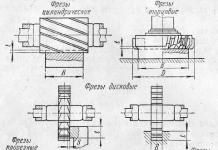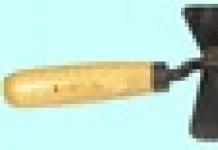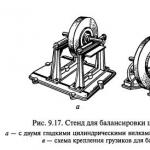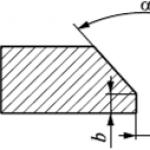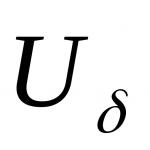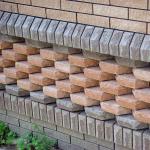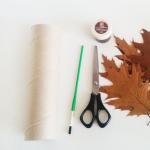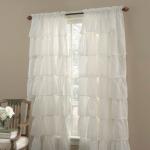The mutual combination of welded elements determines the existing types of welded joints.
Butt joints used when it is necessary to make a flat structure of given dimensions from separate sheets. Sometimes such a structure, after welding, is formed by stamping or rolling into a cylindrical or elliptical product.
Butt joint edges prepared in various standard ways (Table 2.1, Fig. 2.1) depending on the thickness of the sheets being welded and the type of welding.
Rice. 2.1. Types of preparation of edges of butt joints: A - with flange; b- without cutting; V- with V-shaped cutting; G- with X-shaped cutting; d- with U-shaped groove
When connecting metal up to 3 mm thick, the edges are flanged (Fig. 2.1, A), and then welded, as a rule, without filler material with a non-consumable electrode - graphite or tungsten, depending on the properties of the metal. This method is used in the manufacture of non-critical structures that do not bear significant forces and loads during operation (canisters, air ducts, fan housings, electrical busbars, etc.).
State standards for the main types of welds and welded joints, their structural elements and dimensions
Table 2.1
|
Standard |
||
|
Arc in shielding gas Electroslag- |
GOST 14771-76 “Arc welding in shielding gas. Welded connections. Basic types, structural elements and dimensions" GOST 15164-78 “Electroslag welding. Welded connections. Basic types, structural elements and dimensions" |
|
|
Steels and alloys based on iron-nickel and nickel bases |
Manual arc |
GOST 5264-80 “Manual arc welding. Welded connections. Basic types, structural elements and dimensions" |
|
Submerged |
GOST 8713-79 “Submerged arc welding. Welded connections. Basic types, structural elements and dimensions" |
|
|
The same ones, at acute and obtuse angles |
Arc in shielding gases |
GOST 23518-79 “Arc welding in shielding gases. Welded connections at acute and obtuse angles. Basic types, structural elements and dimensions" |
|
Carbon and low alloy steels |
Automatic and semi-automatic submerged arc at acute and obtuse angles |
GOST 11533-75 “Automatic and semi-automatic submerged arc welding. Welded connections at acute and obtuse angles. Basic types, structural elements and dimensions" |
End of table. 2.1
|
Weldable materials to be joined |
Standard |
|
|
Carbon and low alloy steels (thickness up to 60 mm inclusive) |
Manual arc with a consumable electrode in all spatial positions |
GOST 11534-75 “Manual arc welding. Welded connections at acute and obtuse angles. Basic types, structural elements and dimensions" |
|
Reinforcement and embedded products from rod and wire reinforcing steel with a diameter of 3 to 10 mm, sheet rolled products in the manufacture of reinforced concrete products, monolithic and prefabricated reinforced concrete structures |
Contact and arc |
GOST 14098-91 “Welded connections of reinforcement and embedded products of reinforced concrete structures. Types, designs and sizes" |
|
Steels, copper, aluminum and nickel alloys |
Spot, |
GOST 14776-79 “Arc welding. Spot welded connections. Basic types, structural elements and dimensions" |
|
Steel pipelines (except connections used for the manufacture of pipes from sheet or strip metal) |
GOST 16037-80 “Welded steel connections for pipelines. Basic types, structural elements and dimensions" |
|
|
Double-layer corrosion-resistant steel |
GOST 16098-80 “Welded joints made of two-layer corrosion-resistant steel. Basic types, structural elements and dimensions" |
Listed in table. 2.1 standards regulate, for various metal thicknesses, the type of connection, the shape and dimensions of edge preparation, the nature of the weld, the shape and structural elements of its cross-section, and the symbol of the welded joint. The standards define the structural elements of edge preparation and possible deviations of their main dimensions, as well as the dimensions of seams and maximum deviations of their parameters.
If full welding is possible on one or both sides, cutting is not performed (Fig. 2.1, b), but if it is not possible to reliably weld the root of the seam on both sides, cut the edges (Fig. 2.1, c, d) mechanical or thermal methods (electric air, gas or plasma treatment). Its main parameters are shown in Fig. 2.2.
Sometimes the groove is performed to accommodate excess electrode metal, especially when welding fillet welds.

Rice. 2.2. V-butt joint edge preparation parameters: A- gap; b - dullness; A - opening angle
V -shaped cutting carried out with a small thickness of the sheets being welded (up to 20 mm) if double-sided welding is impossible, for example, when making a longitudinal or circumferential seam in a small-diameter pipe. Then, for high-quality formation of the root of the seam, replaceable or remaining linings are used. Penetration of the weld root in the “suspended” position with a tungsten electrode without additives is also used. The disadvantage of such cutting is increased stress and deformation in the structure.
X-cut performed when welding metal with a thickness of 20-40 mm. At the same time, higher productivity is achieved (less deposited electrode metal is required than with V-shaped cutting). Another advantage is the reduction of stress and deformation due to the symmetrical shape of the cutting.
U -shaped cutting used for welding metal with a thickness of more than 40 mm. This cut is the most difficult. Welding of metal of such thicknesses is carried out mainly by mechanized methods.
Welding parts of unequal thickness perform as for parts of the same thickness, if the difference in thickness does not exceed the values given in GOST 5264-80, GOST 8713-79, GOST 4771-76, GOST 16098-80. Thus, in manual arc welding (GOST 5264-80) for thicknesses of a thin part 1-20 mm, the permissible difference is 1-2 mm, and for thicknesses 21-30 mm this figure reaches 3 mm. When automatic submerged arc welding (GOST 8713-79) for thicknesses of a thin part 5-30 mm, a difference of 2 mm is allowed, and when welding in a shielding gas environment (GOST 14771-76) for thicknesses of a thin part from 4 to 40 mm - accordingly from 2 up to 4 mm.
If parts of unequal thickness are welded, the structural elements of edge preparation and the dimensions of the seam must be selected according to the greater thickness. If there are large differences on parts with greater thickness, it is necessary to bevel on one or both sides to the thickness of the thin part. In this case, the structural elements of the prepared edges and the dimensions of the weld are selected based on their smaller thickness.
When welding butt joints (except for pipes), according to GOST 5264-80, GOST 8713-79 and GOST 14771-76, displacements of the welded edges relative to one another are allowed. Displacement 5 is 0.5 mm with a part thickness of 5-4 mm and 6 = 1.1 mm at 4-10 mm. If thickness S= 10-100 mm, then the displacement is 0.15, but not more than 3 mm and 5 = 0.01S + 2 at S> 100 mm, but not more than 4 mm.
Overlap connection weld metal up to 20 mm thick. This type of connection is used instead of a butt connection when a patch is made of a small area or when fitting sheets is difficult, for example, when welding under water. The performance of such a connection is lower than that of a butt connection due to the additional bending moment. Overlapping joints are used when installing reinforcement duplicate sheets, the thickness of which is no less than the main ones, under mechanisms and devices, when lining containers and other elements of devices with corrosion-resistant metal. In these cases, a seam is made along the perimeter of the sheet, as well as slotted seams or electric rivets for fastening over the entire surface.
Gusset(Fig. 2.3, A) performed when it is necessary to form a three-dimensional structure such as a boiler, box, tank, beam of large cross-section, etc. In this case, the angle between the parts that are connected can be straight, obtuse or acute. If penetration through the entire thickness is necessary, cutting is performed as with butt joints.

Rice. 2.3. Angular (a) and T-shaped (b) connections
T-joint(Fig. 2.3, b) used to reinforce flat sheet panels with stiffening ribs and give them stability (sections that form the hull of a ship, straight-walled tanks, etc.). Stiffening ribs in the form of an angle or a T-bar should be installed on the sheet only as a wall and welded to it with a one-sided continuous seam or a double-sided intermittent one, made in a chain or in a checkerboard pattern. It is not recommended to use profiles such as I-beams, channels or corners welded with a flange as stiffeners. This increases the volume of welding work, leads to heavier construction and the development of corrosion processes under the profile flange.
When welding fillet welds, the permissible concavity and convexity of the seams are regulated; GOST 5264-80, GOST 8713-79 and GOST 14771-76 limit the concavity of the seam to 30% of the seam leg TO, but not more than 3 mm, the same convexity of the seam is allowed, provided that it does not reduce the estimated length of the leg. According to GOST 16098-80, when welding in the lower position, the concavity, depending on the leg of the weld LG, should not exceed 1.5 mm at K 5 mm; 2.5 mm at 5 mm K 10 mm; 3.5 mm at TO> 10 mm. If welding is performed in other spatial positions, an increase in concavity by 1 mm is allowed.
The height of the fillet weld legs in accordance with GOST 5264-80 and GOST 8713-79 is determined at the design stage of the welded structure, but should be no more than 3 mm for parts up to 3 mm thick and no more than 1.2 times the thickness of a thinner part when welding thick metal more than 3 mm. The maximum deviations of the dimensions of each of the legs of the fillet weld from the nominal value must be 1 mm at To 5mm and 2mm at K> 6 mm.
The minimum dimensions of fillet weld legs according to GOST 5264-80 and 8713-79 are given in table. 2.2.
Minimum dimensions of fillet weld legs for thicker welded element
Table 2.2
GOST 11969-93 establishes the main spatial welding positions (bottom, vertical, horizontal, ceiling and inclined) and their designations for welds that are performed by fusion welding in one or more layers.
Control questions
- 1. What types of welded joints are used? Where are they used?
- 2. How are edges prepared for welding? Name the advantages and disadvantages of certain types of training.
- 3. What is the purpose of cutting edges?
- 4. What edge cutting parameters depend on the type of welding?
- 5. What is the opening angle of the edges? What is it equal to?
- 6. Why are the edges assembled with a gap?
- 7. What determines the magnitude of dullness?
- 8. Why is it not recommended to use profiles such as a channel, an I-beam or an angle welded with a flange to the panel for stiffening ribs?
- 9. How is the fillet weld leg size selected?
Melting metal 5 mm thick or more is quite a difficult task when using manual arc welding. Obtaining a high-quality weld under these conditions is difficult even for experienced welders.
For this reason, GOSTs and other guidance documents require that the edges of workpieces be formed accordingly. Cutting edges for welding is done when making almost all corner and butt joints.
The only purpose of cutting edges is the desire to obtain a high-quality, reliable seam. The cutting is carried out so that the electrode can easily reach the lower layers and boil the product throughout its entire thickness.
It is carried out in any case. She may be:
- without cutting;
- with flange;
- with cutting.
The mandatory preparatory stage consists of cleaning the end and adjacent area from all kinds of mechanical and greasy contaminants, oxide films, and rust to a distance of at least 20 mm in accordance with GOST.
Cleaning can be done manually using sandpaper, a brush with metal bristles, a file, a grinder or using chemical reagents.
Once the parts are assembled into an assembly that is to be welded and fixed, it will no longer be possible to properly process the edges.
Double-sided flanging is performed during butt welding. In general, cutting involves giving the edges a certain shape, as a result of which they become thinner.
Bevels
 Joints with grooved edges are available with one-sided bevel of one or two edges and with double-sided bevel of one or two joints. Bevels can be straight or curved, with or without blunting.
Joints with grooved edges are available with one-sided bevel of one or two edges and with double-sided bevel of one or two joints. Bevels can be straight or curved, with or without blunting.
When welding on one side, the joints are cut in the form of the letter V or U. When welding on both sides, K or X-shaped grooves are made. Cutting for one-sided welding is more labor-intensive than for welding on both sides.
The choice of edge bevels for welding is determined by the design of the products being welded, the thickness of the metal and the diameter of the electrode. The shape of the cut is determined by the angle and shape of the bevel, as well as the height of the bluntness.
The blunt part is the part of the joint that is not beveled. It is necessary for the correct formation of the weld and to prevent burn-through. The dullness varies in thickness from 1 to 3 mm.
Sometimes they do without it completely. Then special measures are taken to prevent burn-through of the weld. Welding is carried out on a lining, a flux base, or using a locking connection.
When using manual electric arc welding, edge preparation for metal less than 5 mm thick is not done. If the product is thicker, then a one-sided symmetrical cut with an angle of 60°-80° and a bluntness of 1-3 mm is usually used.
For butt joints with K-, V-, and X-shaped edge processing, the cumulative bevel angle is 45°-55°, and when welding with a backing - 10°-12°. These parameters affect the properties of the seam and directly determine its characteristics.
Cutting methods
Cutting an edge involves removing part of the metal from the end of the part at an angle. The angle is determined between the plane of the end and the resulting bevel.
Cutting can be done mechanically and thermally. Subsequently, depending on the quality of the formed surface, mechanized or manual finishing is carried out.
Mechanized finishing is carried out on boring equipment for rotating bodies. For straight surfaces, milling machines or pneumatic grinders are used.
If there is no special equipment, then the surface for welding can be modified manually using a chisel and file.
Thermal methods for cutting edges are gas (using oxygen), plasma and laser cutting. When thermal cutting, you can get K-, V-, and X-shaped edge bevels. Mechanical methods include milling, planing, abrasive cutting and slotting devices.
Features of cutting methods
 When oxyfuel cutting of alloy steels, free carbon forms carbides, which are very difficult to remove. Therefore, the preparation of alloys such as chrome-plated stainless steel, for example, is carried out in other ways. Gas beveling is used mainly for carbon steels.
When oxyfuel cutting of alloy steels, free carbon forms carbides, which are very difficult to remove. Therefore, the preparation of alloys such as chrome-plated stainless steel, for example, is carried out in other ways. Gas beveling is used mainly for carbon steels.
The quality of manual thermal cutting almost always leaves much to be desired, so it is necessary to additionally treat the cut with abrasive. In addition, the composition and properties of the top layer change, which leads to deformation of the products.
Plasma cutting allows you to get a high-quality cut of almost any metal. Air is used as the plasma-forming gas. Portable thermal cutting devices are equipped with gas and plasma torches. When installing three burners, you can make K-shaped bevels on the edges.
With machine thermal cutting, the quality of the edges is high and meets the requirements of GOST standards. Laser cutting of edges is used when there is nothing to replace it with, it is very expensive.
Mechanical cutting ensures high-quality edge bevels. The advantages include the creation of bevels of complex shapes. But there are also significant disadvantages, including low productivity and difficulty in forming edges on large workpieces.
When forming double-sided bevels using a mechanical method, turning of the workpieces is required. Cutting joints with abrasives is hazardous and requires a lot of manual labor. Abrasive elements cause cracks.
Mechanical cutting equipment
The main mechanical methods for preparing joints are milling, gouging, slotting and abrasive cutting.
Edge planing machines are used when cutting joints of straight workpieces and allow you to obtain any type of edge cutting. Edge milling equipment can work with curved workpieces.
 Portable devices are used to prepare pipeline joints. Edge splitting equipment operates at high speed, but the edges require further finishing.
Portable devices are used to prepare pipeline joints. Edge splitting equipment operates at high speed, but the edges require further finishing.
Grinding machines are used to finish joints with abrasives. This treatment is used after milling stainless steel and aluminum products.
All edge cutting methods have their pros and cons, it all depends on the specifics, the type of workpiece being processed, working conditions and the required processing accuracy.
Melting metal 5 mm thick or more is quite a difficult task when using manual arc welding. Obtaining a high-quality weld under these conditions is difficult even for experienced welders. For this reason, GOSTs and other guidance documents require that the edges of workpieces be formed accordingly. Cutting edges for welding is done when making almost all corner and butt joints.
Mandatory training
The only purpose of cutting edges is the desire to obtain a high-quality, reliable seam. The cutting is carried out so that the electrode can easily reach the lower layers and boil the product throughout its entire thickness.
Preparation of edges before welding is carried out in any case. She may be:
- without cutting;
- with flange;
- with cutting.
The mandatory preparatory stage consists of cleaning the end and adjacent area from all kinds of mechanical and greasy contaminants, oxide films, and rust to a distance of at least 20 mm in accordance with GOST. Cleaning joints for welding can be done manually using sandpaper, a brush with metal bristles, a file, a grinder, or using chemical reagents.
Once the parts are assembled into an assembly that is to be welded and fixed, it will no longer be possible to properly process the edges.
It is recommended to prepare joints when the wall thickness of the parts being welded is 5 mm or more. One-sided flanging is performed when welding butt and corner joints. Double-sided flanging is performed during butt welding. In general, cutting involves giving the edges a certain shape, as a result of which they become thinner.
Bevels
Joints with grooved edges are available with one-sided bevel of one or two edges and with double-sided bevel of one or two joints. Bevels can be straight or curved, with or without blunting.
When welding on one side, the joints are cut in the form of the letter V or U. When welding on both sides, K or X-shaped grooves are made. Cutting for one-sided welding is more labor-intensive than for welding on both sides.
The choice of edge bevels for welding is determined by the design of the products being welded, the thickness of the metal and the diameter of the electrode. The shape of the cut is determined by the angle and shape of the bevel, as well as the height of the bluntness.
The blunt part is the part of the joint that is not beveled. It is necessary for the correct formation of the weld and to prevent burn-through. The dullness varies in thickness from 1 to 3 mm. Sometimes they do without it completely. Then special measures are taken to prevent burn-through of the weld. Welding is carried out on a lining, a flux base, or using a locking connection.
When using manual electric arc welding, edge preparation for metal less than 5 mm thick is not done. If the product is thicker, then a one-sided symmetrical cut with an angle of 60°-80° and a bluntness of 1-3 mm is usually used.
For butt joints with K-, V-, and X-shaped edge processing, the cumulative bevel angle is 45°-55°, and when welding with a backing - 10°-12°. These parameters affect the properties of the seam and directly determine its characteristics.
Cutting methods
Cutting an edge involves removing part of the metal from the end of the part at an angle. The angle is determined between the plane of the end and the resulting bevel. Cutting can be done mechanically and thermally. Subsequently, depending on the quality of the formed surface, mechanized or manual finishing is carried out.
Mechanized finishing is carried out on boring equipment for rotating bodies. For straight surfaces, milling machines or pneumatic grinders are used. If there is no special equipment, then the surface for welding can be modified manually using a chisel and file.
Thermal methods for cutting edges are gas (using oxygen), plasma and laser cutting. When thermal cutting, you can get K-, V-, and X-shaped edge bevels. Mechanical methods include milling, planing, abrasive cutting and slotting devices.
Features of cutting methods
 When oxyfuel cutting of alloy steels, free carbon forms carbides, which are very difficult to remove. Therefore, the preparation of alloys such as chrome-plated stainless steel, for example, is carried out in other ways. Gas beveling is used mainly for carbon steels.
When oxyfuel cutting of alloy steels, free carbon forms carbides, which are very difficult to remove. Therefore, the preparation of alloys such as chrome-plated stainless steel, for example, is carried out in other ways. Gas beveling is used mainly for carbon steels.
The quality of manual thermal cutting almost always leaves much to be desired, so it is necessary to additionally treat the cut with abrasive. In addition, the composition and properties of the top layer change, which leads to deformation of the products.
Plasma cutting allows you to get a high-quality cut of almost any metal. Air is used as the plasma-forming gas. Portable thermal cutting devices are equipped with gas and plasma torches. When installing three burners, you can make K-shaped bevels on the edges.
With machine thermal cutting, the quality of the edges is high and meets the requirements of GOST standards. Laser cutting of edges is used when there is nothing to replace it with, it is very expensive.
Mechanical cutting ensures high-quality edge bevels. The advantages include the creation of bevels of complex shapes. But there are also significant disadvantages, including low productivity and difficulty in forming edges on large workpieces. When forming double-sided bevels using a mechanical method, turning of the workpieces is required. Cutting joints with abrasives is hazardous and requires a lot of manual labor. Abrasive elements cause cracks.
Mechanical cutting equipment
The main mechanical methods for preparing joints are milling, gouging, slotting and abrasive cutting.
Edge planing machines are used when cutting joints of straight workpieces and allow you to obtain any type of edge cutting. Edge milling equipment can work with curved workpieces. Portable devices are used to prepare pipeline joints. Edge splitting equipment operates at high speed, but the edges require further finishing.
Grinding machines are used to finish joints with abrasives. This treatment is used after milling stainless steel and aluminum products.
All edge cutting methods have their pros and cons, it all depends on the specifics, the type of workpiece being processed, working conditions and the required processing accuracy.
svaring.com
Preparation of edges for welding
 |  |
||
Figure 7 - Elements of the geometric shape of preparing edges for welding (a) and seams (b):
in - seam width, h - seam height, K - seam leg
The choice of the form of semi-prepared edges for welding is regulated by GOSTs and technical conditions.
GOST 5264-80 establishes the main types, structural elements and dimensions of welded joints made of steels, as well as alloys on iron-nickel and nickel bases, performed by manual and arc welding. It provides for butt joints the forms of prepared edges presented in ... fig. 8; for corner connections - in Fig. 9; T-bars - in Fig. 10 and overlap - in Fig. eleven.
The edges of the parts to be welded can be prepared in various ways: without beveled edges, with a bevel of one edge, with a bevel of two edges, with two symmetrical bevels of one edge, with flanged edges, etc. To distinguish them, a digital designation of the type of prepared edges is added to the corresponding letter symbol : C1, C2, NW, etc.; U1, U2, UZ,...; H1, H2, NZ,…; T1, T2, TZ,….
Figure 8 - Form of prepared Figure 9 - Form of prepared
edges for welding for edges for welding for
butt joints corner joints
Figure 10 - Form of prepared Figure 11 - Form of preparation
welded edges for welded edges
T-joints for lap joints
Preparation of edges for welding is carried out on mechanical machines - lathes (processing of pipe ends), milling, planing - processing of sheets, etc., as well as using thermal cutting. Sheets and pipes made of carbon steel are processed by oxy-fuel cutting. The flammable gases can be acetylene, propane, coke oven gas, etc. Non-ferrous metals, as well as stainless steels, are processed by plasma cutting.
Before welding particularly critical structures, the ends of pipes or sheets after oxy-fuel cutting are additionally processed mechanically; this is done in order to avoid any inclusions in the metal.
Main types of welded joints
| Connection type | Uniform prepared | Character of the weld | Cross-sectional shape | Thickness of welded | Symbol | |
| edges | prepared edges | weld | parts, mm | connections | ||
| Butt | With beaded edges | Unilateral | 1-4 | C1 | ||
| 1-12 | S28 | |||||
| With flange on one edge | 1-4 | C3 | ||||
| C2 | ||||||
| 1-4 | C4 | |||||
| No beveled edges | C5 | |||||
| Single-sided locking | 1-4 | C6 | ||||
| Double sided | 2-5 | C7 | ||||
| No beveled edges | 6-12 | S42 | ||||
| subsequent track | ||||||
| Unilateral | C8 | |||||
| Single-sided with removable lining | C9 | |||||
| With one edge beveled | Single sided with remaining lining | 3-60 | C10 | |||
| Single-sided locking | C11 | |||||
| C12 | ||||||
| With a curved bevel of one edge | 15-100 | C13 | ||||
| With a broken bevel on one edge | Double sided | C14 | ||||
| 8-100 | C15 | |||||
| 30-120 | C16 | |||||
| With two symmetrical bevels on one edge | 12-100 | C43 | ||||
| With beveled edges | Unilateral | 3-60 | C17 | |||
| Single-sided with removable lining | C18 | |||||
| With beveled edges | Single sided with remaining lining | 6-100 | C19 | |||
| Single-sided locking | 3-60 | S20 | ||||
| S21 | ||||||
| With beveled edges | 8-40 | C45 | ||||
| followed by a track | ||||||
| Butt | With curved edges | Bilateral | 15-120 | S23 | ||
| With broken bevel edges | S24 | |||||
| With two symmetrical edge bevels | 8-120 | S25 | ||||
| With two symmetrical curved edge bevels | 30-175 | S26 | ||||
| With two symmetrical broken edges | 30-75 | S27 | ||||
| With two asymmetrical edge bevels | 12-120 | C39 | ||||
| C40 | ||||||
| Angular | With flange on one edge | 1-4 | U1 | |||
| One-sided | 1-12 | U2 | ||||
| No beveled edges | 1-6 | U4 | ||||
| 1-30 | ||||||
| Bilateral | 2-8 | U5 | ||||
| 2-30 | ||||||
| With one edge beveled | Unilateral | 3-60 | U6 | |||
| Bilateral | U7 | |||||
| Angular | With two symmetrical bevels on one edge | 8-100 | U8 | |||
| With beveled edges | Unilateral | 3-60 | U9 | |||
| Bilateral | U10 | |||||
| No beveled edges | Unilateral | 2-10 | T1 | |||
| Bilateral | T3 | |||||
| Tavrovoe | With one edge beveled | Unilateral | 3-60 | T6 | ||
| T7 | ||||||
| With a curved bevel of one edge | 15-100 | T2 | ||||
| With two symmetrical bevels on one edge | Bilateral | 8-100 | T8 | |||
| 12-100 | T9 | |||||
| With two symmetrical curved bevels on one edge | 30-120 | T5 | ||||
| Overlapping | No beveled edges | Unilateral | 2-60 | H1 | ||
| Bilateral | H2 |
refac.ru
WELDING. Choosing the form of edge preparation
The main types of joints made by electric arc welding are butt (C), corner (U), T (T) and lap (H). The main types, structural elements and dimensions of welded joints made by manual welding with metal electrodes with a welded product thickness of up to 175 mm are regulated by GOST.
Thus, Figure 4.1 shows examples of butt and corner joints. A butt joint is characterized by the following parameters: weld width e, penetration depth h, reinforcement height q, weld thickness H. Fillet joint - weld leg k.

a – butt connection; b – corner connection
Figure 4.1 – Section of the weld
Conventional images and designations of seams of welded joints in the drawings are established by GOST. According to GOST, depending on the thickness of the metal being welded, for each type of joint, a certain form of preparation of edges for welding (grooving form) is established.
Figure 4.2, for example, shows the main types of forms for preparing the edges of butt joints according to GOST. The main structural elements of edge preparation are: opening angle, bluntness value c, gap value b (Figure 4.2).

a – with flanged edges; b – without beveled edges; c – with bevel
one edge; d – with a curved bevel of one edge;
d – with two bevels of one edge; e – with two curved
bevels of one edge; g – with beveled edges; z – with two
symmetrical beveled edges; and – with two symmetrical
curved edge bevels
Figure 4.2 – Form of preparation of edges of butt joints
When designing the structure and technological processes for manufacturing welded joints, the problems of choosing the preparation of edges, seams and joints are constantly solved. In general, edge preparation is necessary to obtain quality seams and joints. This includes, first of all, obtaining seams of a given shape, i.e., with geometric dimensions corresponding to the dimensions specified by GOST. Preparation of edges for welding, assembly without bevel of edges with a mandatory gap are used to ensure penetration of the welded elements to their entire thickness.
The technology of electric arc welding of workpieces without special preparation of edges in many cases is more progressive and economical, since in this case mechanical processing of the edges, associated with the removal of metal as waste and labor costs, is not required; during subsequent welding, as a rule, the seams have a smaller cross-sectional area and, therefore, a smaller mass of deposited metal, therefore it requires minimal consumption of coated electrodes, electricity, and minimal manual labor of the welder.
In this regard, the following should be considered as the main indicators when assessing the effectiveness of choosing the form of edge preparation:
– cross-sectional area or mass of metal removed from the edges and the complexity of processing;
– cross-sectional area or linear mass of the deposited weld metal.
The smaller the mass of metal removed from the edges and the mass of deposited weld metal for a given quality of the welded joint, the more economical the form of edge preparation.
A welded joint, according to GOST, has a conventional letter designation, in which the letter indicates the type of connection, the figure or number is a serial number corresponding to a specific edge preparation. For example, the symbol C17 denotes a butt joint with a V-shaped one-sided bevel of the edges, used with a metal thickness of 3...60 mm. If such a connection uses a seam with root welding, then it is designated C18, etc. GOST establishes forty types of butt joints (C1 - C40), ten corner joints (U1 - U10), eight T-joints (T1 - T8) and two lap joints.
Lectures teach welding students the basics and importance of each preparatory step before welding. Students know the purpose of cutting edges, and in practical classes they train with various types of welded joints and their preparation.
Article menu:
This article will talk about the basic features of welding: the correct preparation of metal edges, types of joints and preparation methods in accordance with GOST.
Why prepare edges and how to properly treat the surface
Preliminary cutting edges for welding when the metal thickness is 5 millimeters, it is mandatory, in accordance with welding standards. This is done so that the welding of the elements is deep, the liquid metal of the electrode fills the cavities between the parts being connected, and the frozen seam ensures the strength of the structure.
State standards for edge preparation are individually selected for all types of welded joints (seams) of sheet metal:
T-shaped (T-shaped);
Overlapping.
Butt;
Cutting edges for pipe welding is a separate collection of certified standards for processing the edges of pipe joints. GOST standards also distinguish between butt, lap and corner joints, where the bevel of the edges is selected based on the thickness of the metals being welded.
When the sections and bevels are made according to the standards, the welders proceed to another, no less important stage of preparation - cleaning and degreasing. To do this, the master uses a special manual steel brush or abrasive grinding wheels, and then a solvent or acetone to chemically degrease the surface.

Degreasing and cleaning before welding are integral features of high-quality professional work. Welding elements are cleaned after cutting and degreased from traces of rust, oily structures, moisture, and scale. Failure to complete this step leads to irreversible consequences:
Brittle weld;
Inhomogeneous weld (slag inclusions in the metal);
The appearance of pores and micro-airs in the seam;
The appearance of cracks along the seam;
Burnout, overheating of metal.
It is important to follow the sequence of actions:
Cut off.
Prepare the edge (chamfer).
Remove traces of corrosion, old paint, varnish and other materials.
Degrease.
Only after this can you make basting and tacks, and there will no longer be an opportunity to process the edges.

Types of finished edges - what they are and how to choose
Types of edge preparation According to State Standards, a lot of parameters are taken into account, which have their own terms:
Edge cutting angle (α) - its presence ensures a tight seam and a high-quality weld pool.
Edge bevel length (L) - ensures a smooth transition of metal thickness.
The size of the edge blunting (S) - begins where the bevel ends and ensures stability of the weld and uniform application of the seam.
The gap between the two edges (a) requires care and the right approach, because the completeness of the penetration depends on its size.
The displacement of the edges relative to each other (δ) affects the strength of the connection and is allowed no more than 10% of the metal thickness.

An experienced welder knows all types of edge preparation for welding according to GOST and knows how to select them depending on the thickness of the metal, type of connection and welding method. The standard for the most common manual arc welding (GOST 5264-80) includes 4 or more types of edge shapes for each type of connection:
For butt - 15 types of edges;
For corner - 5 types of edges;
For T-bar - 4 types of edges;
For overlap - one type: without bevel of edges.

These linear types of welded joints, where preliminary cutting of the edges is required, are found at every step:
Metal structures;
Metal installations - objects of art;
Spiral and fire escapes;
Certain types of railings and fences;
In shipbuilding and repair.

Edges for pipe welding, GOST standards and features
Cutting edges for pipe welding occupies a separate category, since pipe joints are more complex and require durability. It is difficult to list all the areas of activity where pipes are “boiled”; the most common areas are:
Water supply and sewerage;
Heating - pipes and radiators;
Domestic gas pipeline;
Pipes + fittings;
Gas and oil pipeline.
Cutting pipe edges for GOST welding 16037-80 applies to connections made of steel and takes into account the characteristics of the elements being connected and the types of connections:
Design parameters of elements (pipes, fittings);
Overall dimensions (diameter and thickness);
Type of connection (C - butt, U - corner and H - lap).
The conditions and requirements described in the standards are mandatory and are the defining features of high-quality and “correct” welding. They are suitable for manual arc welding, gas shielded arc welding, submerged arc welding and gas welding. The basic conventions are described in detail in Standard 16037-80.
High-quality cleaning and degreasing of the surface of the edges and those pipe elements that will be involved in welding is also mandatory.
The cut of a pipe or section is made according to the marks marked on the pipe: you need to cut carefully, taking into account the thickness of the pipe and the characteristics of the cutting wheel (if you are using an angle grinder).

Brief conclusions
Welding metal structures and pipes is an extremely responsible and complex job that requires experience and certain theoretical knowledge.
Proper preparation of the edges of the elements being welded guarantees the future strength of the seam and the durability of the entire structure.
The basic conditions for preparing edges are collected in generally accepted state standards and are determined by GOSTs, depending on the welding methods used.
§ 28. Preparation of metal for welding
Preparing the metal surface for welding. When preparing parts for welding, the incoming metal is subjected to straightening, marking, marking, cutting, preparing edges for welding, cold or hot bending.
The metal is straightened either by hand or on various sheet straightening rollers. Manual straightening is performed on cast iron or steel leveling plates by blows of a sledgehammer or using a manual screw press. Angle steel is straightened on leveling rollers (presses), I-beams and channels - on driven or manual leveling presses.
Marking and basting are operations that determine the configuration of the future part. Mechanical cutting is used for straight cutting of sheets, and sometimes for curved cutting of sheets using roller shears with circular knives for this purpose. Carbon steels are cut using oxy-fuel and plasma-arc cutting. These methods can be manual or mechanized. For cutting alloy steels and non-ferrous metals, gas-flux or plasma-arc cutting can be used.
Before welding, the base metal and filler material must be thoroughly cleaned of rust, oil, moisture, scale and various types of non-metallic contaminants. The presence of these contaminants leads to the formation of pores, cracks, and slag inclusions in welds, which leads to a decrease in the strength and density of the welded joint.
Preparation of edges for welding. The elements of the geometric form of preparing edges for welding (Fig. 25) include the cutting angle of the edges α, the bluntness of the edges S, the bevel length of the sheet L in the presence of a difference in metal thickness, the offset of the edges relative to each other b, the gap between the joined edges a.
Rice. 25. Elements of the geometric shape of preparing edges for welding (a) and seams (b):
in - seam width, h - seam height, K - seam leg
The cutting angle of the edges is carried out when the metal thickness is more than 3 mm, since the absence of cutting edges can lead to lack of penetration along the cross-section of the welded joint, as well as to overheating and burnout of the metal; In the absence of edge preparation, the electric welder must increase the welding current to ensure penetration.
Grooving the edges allows welding to be carried out in separate layers of small cross-section, which improves the structure of the welded joint and reduces the occurrence of welding stresses and deformations.
The gap, correctly set before welding, allows for complete penetration along the cross-section of the joint when applying the first (root) layer of the seam, if the appropriate welding mode is selected.
The length of the sheet bevel regulates a smooth transition from a thick welded part to a thinner one, eliminating stress concentrators in welded structures.
Blunting of edges is carried out to ensure stable conduction of the welding process when performing the root layer of the weld. The lack of blunting contributes to the formation of burns during welding.
The displacement of the edges creates additional welding deformations and stresses, thereby worsening the strength properties of the welded joint. The offset of the edges is regulated either by GOSTs or technical conditions. In addition, the displacement of the edges does not allow obtaining a monolithic weld along the cross-section of the edges being welded.
GOST 5264-80 provides for butt joints the forms of prepared edges shown in Fig. 26; for corner connections - in Fig. 27; T-bars - in Fig. 28 and overlap - in Fig. 29.

Rice. 26. Shape of prepared edges for welding for butt joints
Rice. 27. Shape of prepared edges for welding for corner joints

Rice. 28. Shape of prepared edges for welding for T-joints

Rice. 29. Shape of prepared edges for welding for lap joints
The preparation of edges for welding is carried out on mechanical machines - lathes (processing pipe ends), milling machines, planers - processing sheets, etc., as well as using thermal cutting. Sheets and pipes made of carbon steel are processed by oxy-fuel cutting. The flammable gases can be acetylene, propane, coke oven gas, etc. Non-ferrous metals, as well as stainless steels, are processed by plasma cutting.
Before welding particularly critical structures, the ends of pipes or sheets after oxy-fuel cutting are additionally processed mechanically; this is done in order to avoid any inclusions in the metal.
Requirements for the assembly of metal parts before welding. The assembly and welding devices used must ensure accessibility to the installation sites of parts and tacks, to the handles of fixing and clamping devices, as well as to the welding sites. These devices must also be sufficiently strong and rigid, ensure precise fastening of the parts in the desired position and prevent them from deforming during the welding process. In addition, assembly and welding fixtures must ensure the most advantageous order of assembly and welding: the smallest number of turns when applying tacks and welds; free access to check the dimensions of products and their easy removal after production; safety of assembly and welding works.
Any assembly operation should not impede the next operation. Parts received for assembly must be carefully checked; All geometric dimensions of the part and the prepared shape of the edges for welding are subject to verification.
Assembly of welded structures, as a rule, is carried out either according to markings, or with the help of templates, stops, clamps or special devices - jigs that facilitate assembly operations. The preparation and assembly of products for welding is carried out in compliance with the following basic mandatory rules:
the blunting of the edges and the gaps between them must be uniform along the entire length;
the edges of the elements to be welded and the adjacent areas 25-30 mm wide from the end of the edge must be dried, cleaned of burrs after cutting, oil, rust and other contaminants;
to avoid deformation, tack work should be performed with high-quality electrodes at intervals of no more than 500 mm with a length of one tack piece of 50-80 mm;
To ensure normal and high-quality seam formation, you need to tack the strips at the beginning and end of the product.
